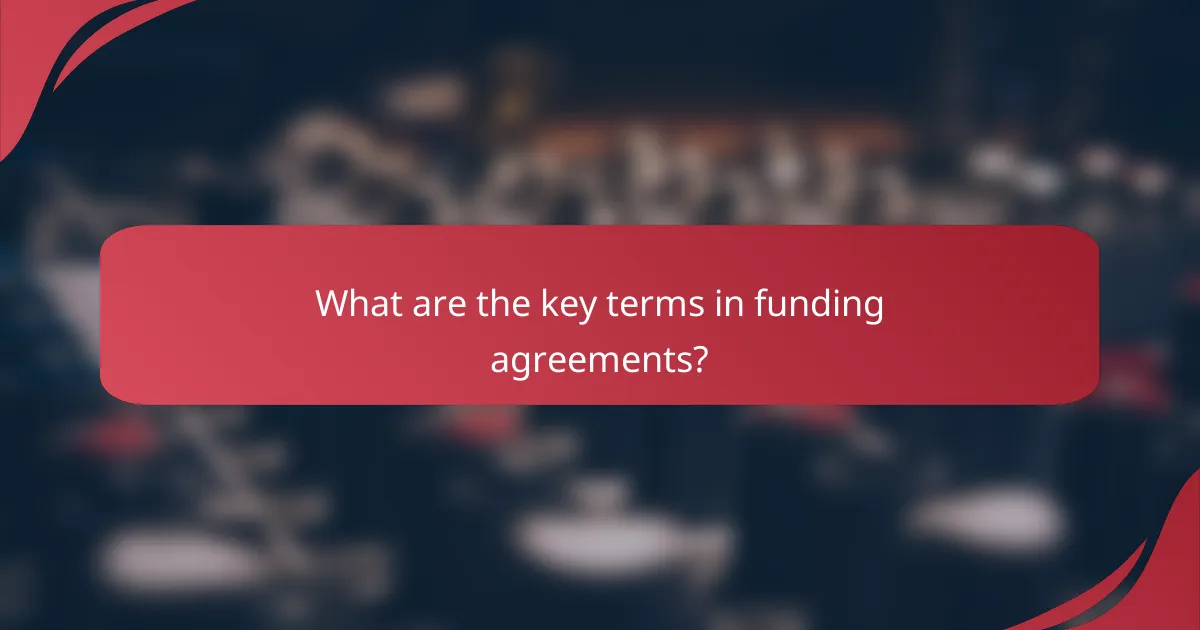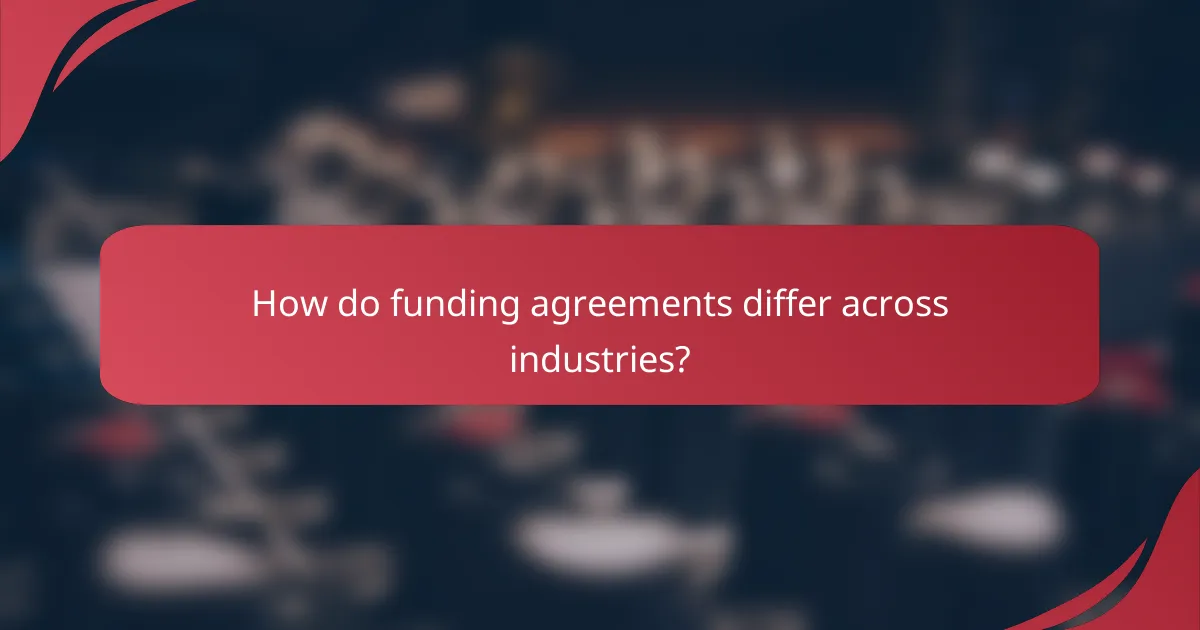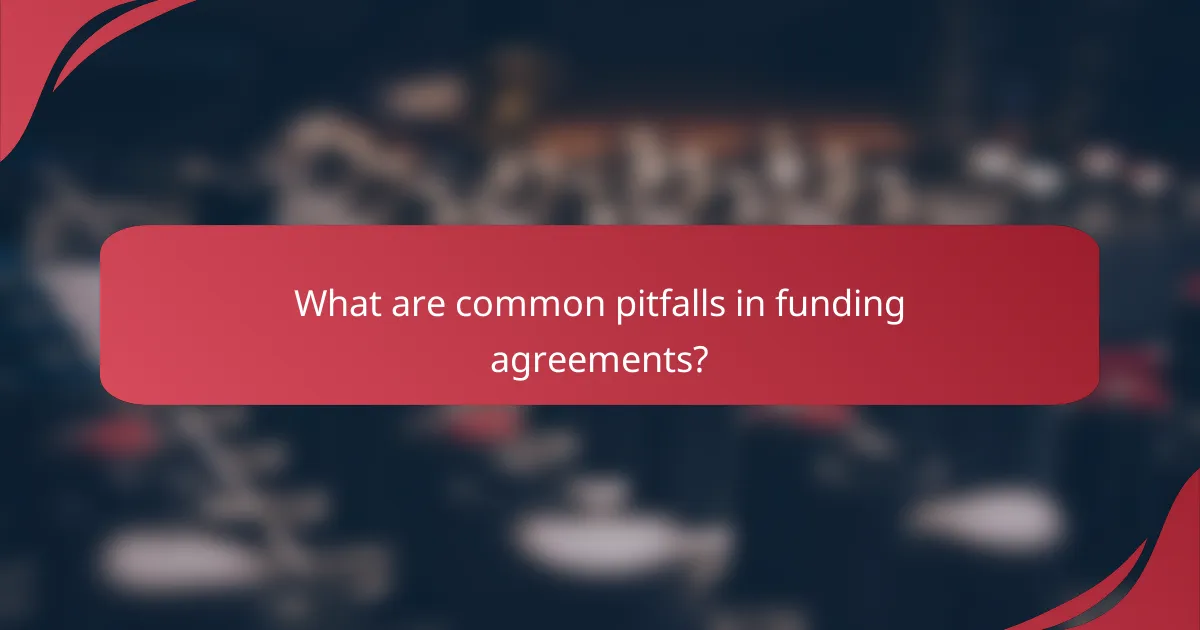Funding agreements are vital for protecting the interests of all parties involved by clearly defining the terms of financial support and expectations. By outlining key terms, these agreements help prevent disputes and ensure that both funders and recipients are aware of their rights and obligations. Effective negotiation strategies can enhance these agreements, promoting clear communication and aligning the interests of all stakeholders.

How can funding agreements protect interests in the UK?
Funding agreements in the UK serve to safeguard the interests of all parties involved by clearly outlining the terms of financial support and expectations. These agreements help prevent disputes and ensure that both funders and recipients understand their rights and obligations.
Legal safeguards for parties
Legal safeguards in funding agreements include clearly defined terms regarding the use of funds, repayment conditions, and consequences for breach of contract. These provisions help protect the interests of both the funder and the recipient by establishing a legal framework for the relationship.
It is essential to include clauses that address confidentiality, intellectual property rights, and dispute resolution mechanisms. Such clauses can prevent misunderstandings and provide a clear path for resolving issues should they arise.
Risk mitigation strategies
Risk mitigation strategies in funding agreements involve assessing potential risks and incorporating measures to address them. This can include setting milestones for fund disbursement, which ensures that funds are released only when specific objectives are met.
Additionally, parties can negotiate insurance requirements or performance bonds to further protect against financial loss. Regular monitoring and reporting can also help identify issues early, allowing for timely intervention.
Enforcement mechanisms
Enforcement mechanisms in funding agreements are critical for ensuring compliance with the terms set forth. These can include specific performance clauses, which require parties to fulfill their obligations, and penalties for non-compliance.
In the UK, parties can also seek legal remedies through the courts if necessary. Including arbitration clauses can provide an alternative dispute resolution method, which may be faster and less costly than traditional litigation.

What are the key terms in funding agreements?
Key terms in funding agreements define the essential elements of the financial relationship between the parties involved. Understanding these terms is crucial for protecting interests and ensuring clarity in expectations.
Definition of funding amount
The funding amount refers to the total capital that a lender or investor agrees to provide to a business or project. This amount can vary widely based on the nature of the project, ranging from low tens of thousands to millions of dollars.
When negotiating, clearly outline the funding amount in the agreement to avoid misunderstandings. It’s also important to specify whether the amount is a one-time payment or a series of disbursements based on milestones.
Repayment terms
Repayment terms detail how and when the borrower will repay the funding received. These terms typically include the repayment schedule, interest rates, and any grace periods.
Common structures involve monthly payments over a set period, often spanning several years. Ensure that the terms are realistic and consider the cash flow of the business to avoid default.
Equity stakes
Equity stakes represent the ownership percentage that an investor receives in exchange for their funding. This can be a critical point of negotiation, as it affects control and profit-sharing within the business.
Equity stakes can range from single-digit percentages to significant shares, depending on the funding amount and the perceived value of the business. Clearly define these stakes in the agreement to prevent future disputes.
Default clauses
Default clauses outline the conditions under which a borrower is considered to be in default on their obligations. These clauses are essential for protecting the interests of the lender or investor.
Typical triggers for default include missed payments, failure to meet financial covenants, or insolvency. It’s crucial to negotiate these clauses carefully, as they can lead to severe consequences, including loss of equity or legal action.

What negotiation tips enhance funding agreement outcomes?
Effective negotiation tips can significantly improve the outcomes of funding agreements by fostering clear communication and aligning interests. Key strategies include thorough preparation, employing effective communication techniques, and understanding the interests of all parties involved.
Preparation and research
Preparation is crucial for successful negotiations in funding agreements. Start by gathering information about potential investors or funding sources, including their past investments, preferences, and decision-making processes. This knowledge helps tailor your approach and anticipate their concerns.
Additionally, familiarize yourself with industry standards and benchmarks related to funding terms. Knowing what is typical can empower you to negotiate terms that are fair and competitive, such as equity stakes or repayment schedules.
Effective communication strategies
Clear and concise communication is vital during negotiations. Use straightforward language to articulate your needs and expectations, avoiding jargon that may confuse the other party. Active listening is equally important; ensure you understand their points and respond thoughtfully.
Establishing rapport can also enhance communication. Building a positive relationship with the other party can lead to more open discussions and a willingness to find mutually beneficial solutions.
Understanding counterpart interests
Understanding the interests of your negotiation counterpart is essential for reaching a favorable agreement. Identify their goals and motivations, which may include financial returns, social impact, or strategic partnerships. This insight allows you to frame your proposals in a way that aligns with their objectives.
Consider conducting informal discussions or surveys to gauge their interests before formal negotiations. This proactive approach can reveal common ground and help you craft offers that appeal to both parties, increasing the likelihood of a successful agreement.

How do funding agreements differ across industries?
Funding agreements vary significantly across industries due to differing regulatory environments, risk profiles, and funding sources. Understanding these differences is crucial for securing appropriate financial support tailored to specific business needs.
Venture capital vs. angel investments
Venture capital (VC) and angel investments are both vital sources of funding for startups, but they differ in structure and expectations. VC firms typically invest larger sums, often in the millions, and seek substantial equity stakes, while angel investors usually provide smaller amounts, often in the low hundreds of thousands, with a more personal touch.
When negotiating with VCs, be prepared for rigorous due diligence and a focus on rapid growth. In contrast, angel investors may offer more flexible terms and a willingness to mentor, making them a good choice for early-stage companies looking for guidance.
Public sector funding agreements
Public sector funding agreements often involve grants or contracts from government entities, which can provide significant financial support without the expectation of equity. These agreements typically require compliance with specific regulations and reporting standards, which can vary by region and funding program.
Organizations seeking public funding should carefully review eligibility criteria and application processes. It’s essential to align project goals with public policy objectives to enhance the likelihood of securing funding.
Non-profit funding terms
Non-profit organizations often rely on grants, donations, and sponsorships, which come with unique funding terms. These agreements may stipulate how funds can be used, reporting requirements, and timelines for project completion.
Non-profits should focus on building relationships with funders and clearly communicating their mission and impact. Understanding the specific terms and conditions of each funding source is crucial to ensure compliance and maintain future funding opportunities.

What are common pitfalls in funding agreements?
Common pitfalls in funding agreements include vague terms, misalignment of interests, and inadequate dispute resolution mechanisms. These issues can lead to misunderstandings and conflicts, jeopardizing the success of the funding arrangement.
Lack of clarity in terms
A lack of clarity in terms can create significant challenges in funding agreements. Ambiguous language may lead to different interpretations of obligations, timelines, and deliverables, which can result in disputes. It is crucial to define all terms clearly to ensure that all parties have a mutual understanding.
To avoid confusion, use precise language and avoid jargon that may not be universally understood. For example, instead of saying “reasonable efforts,” specify what constitutes “reasonable” in the context of the agreement. This can include specific metrics or timelines that are agreed upon by all parties.
Additionally, consider including a glossary of key terms at the end of the agreement. This can serve as a reference point and help prevent misunderstandings. Regularly reviewing and updating the agreement as circumstances change can also help maintain clarity throughout the funding relationship.


